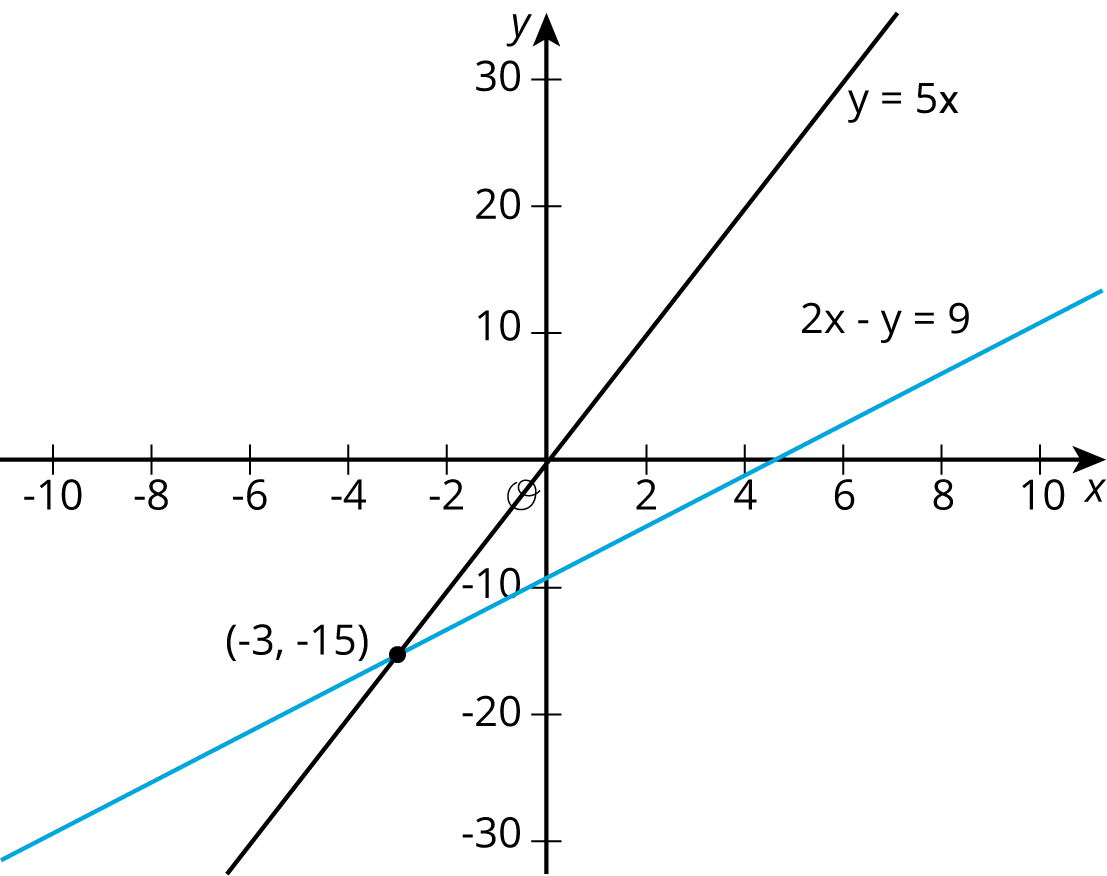Lesson 15
Solving More Systems
Let’s solve systems of equations.
15.1: Algebra Talk: Solving Systems Mentally
Solve these without writing anything down:
\(\displaystyle \begin{cases} x=5\\ y=x-7 \end{cases}\)
\(\displaystyle \begin{cases} y=4\\ y=x+3 \end{cases}\)
\(\displaystyle \begin{cases} x=8\\ y=\text-11 \end{cases}\)
15.2: Challenge Yourself
Here are a lot of systems of equations:
A \(\begin{cases} y= 4 \\ x=\text-5y+6 \end{cases}\)
B \(\begin{cases} y= 7 \\ x=3y-4 \end{cases}\)
C \(\begin{cases} y= \frac{3}{2}x+7 \\ x=\text-4 \end{cases}\)
D \(\begin{cases} y= \text-3x+10 \\ y=\text-2x+6 \end{cases}\)
E \(\begin{cases} y= \text-3x-5 \\ y=4x+30 \end{cases}\)
F \(\begin{cases} y= 3x-2 \\ y=\text-2x+8 \end{cases}\)
G \(\begin{cases} y= 3x \\ x=\text-2y+56 \end{cases}\)
H \(\begin{cases} x=2y-15 \\ y= \text-2x \end{cases}\)
I \(\begin{cases} 3x+4y=10 \\ x=2y \end{cases}\)
J \(\begin{cases} y= 3x+2 \\ 2x+y = 47 \end{cases}\)
K \(\begin{cases} y= \text-2x+5 \\ 2x+3y = 31 \end{cases}\)
L \(\begin{cases} x+y=10 \\ x=2y +1 \end{cases}\)
- Without solving, identify 3 systems that you think would be the least difficult to solve and 3 systems that you think would be the most difficult to solve. Be prepared to explain your reasoning.
- Choose 4 systems to solve. At least one should be from your "least difficult" list and one should be from your "most difficult" list.
15.3: Five Does Not Equal Seven
Tyler was looking at this system of equations:
\(\displaystyle \begin{cases} x + y = 5\\x + y = 7 \end{cases}\)
He said, "Just looking at the system, I can see it has no solution. If you add two numbers, that sum can’t be equal to two different numbers.”
Do you agree with Tyler?
In rectangle \(ABCD\), side \(AB\) is 8 centimeters and side \(BC\) is 6 centimeters. \(F\) is a point on \(BC\) and \(E\) is a point on \(AB\). The area of triangle \(DFC\) is 20 square centimeters, and the area of triangle \(DEF\) is 16 square centimeters. What is the area of triangle \(AED\)?
Summary
When we have a system of linear equations where one of the equations is of the form \(y = \text{[stuff]}\) or \(x=\text{[stuff]}\), we can solve it algebraically by using a technique called substitution. The basic idea is to replace a variable with an expression it is equal to (so the expression is like a substitute for the variable). For example, let's start with the system:
\(\displaystyle \begin{cases} y = 5x\\2x - y = 9 \end{cases}\)
Since we know that \(y = 5x\), we can substitute \(5x\) for \(y\) in the equation \(2x - y = 9\),
\(\displaystyle 2x - (5x) = 9,\)
and then solve the equation for \(x\),
\(\displaystyle x =\text -3.\)
We can find \(y\) using either equation. Using the first one: \(y = 5 \boldcdot \text-3\). So
\(\displaystyle (\text-3,\text -15)\)
is the solution to this system. We can verify this by looking at the graphs of the equations in the system:

Sure enough! They intersect at \((\text-3, \text-15)\).
We didn't know it at the time, but we were actually using substitution in the last lesson as well. In that lesson, we looked at the system
\(\begin{cases} y = 2x + 6 \\ y = \text-3x - 4 \end{cases}\)
and we substituted \(2x+6\) for \(y\) into the second equation to get \(2x+6=\text-3x-4\). Go back and check for yourself!
Glossary Entries
- system of equations
A system of equations is a set of two or more equations. Each equation contains two or more variables. We want to find values for the variables that make all the equations true.
These equations make up a system of equations:
\(\displaystyle \begin{cases} x + y = \text-2\\x - y = 12\end{cases}\)
The solution to this system is \(x=5\) and \(y=\text-7\) because when these values are substituted for \(x\) and \(y\), each equation is true: \(5+(\text-7)=\text-2\) and \(5-(\text-7)=12\).